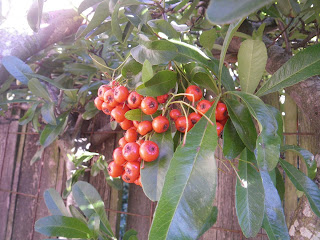Gift giving is a year round opportunity to bring joy to those we love, is it not? This time of year it is of course ramped up as we celebrate this season of Christ’s birth with the giving of gifts following in the tradition of the wise-men that lavished gifts upon the child Jesus (Matthew 2:10-12).
As we consider which gift would bring the most meaning to those in our lives, I have a few ideas to share for the gardeners in your life. Here is my top 10, not necessarily in order of preference, but as ideas came to mind like a shuffling of a Rubik’s Cube, these kept recirculating to the top.
1. Number one and the most obvious of course is a Gift Card from a favorite nursery. If you are unsure what to get, your gardener friend will no doubt already have a list in their head of needs and wants. If however, you’d rather give items not money, read on.
2. Feed the birds – because bird song feeds the soul. If your gardener friend loves birds, and I don’t believe that I’ve met one that doesn’t, anything that will bring birds to the garden year round will be applauded. Bird houses, bird seed, seed cakes and the proper holders for each, suet cakes in winter as well as a heater for the birdbath, there are so many birdy gifts that will delight your gardener friend. Books to help identify the birds that come for a visit are invaluable. And don’t forget about the butterflies and bats, as both are extremely beneficial to the planet. There are identification books galore and specially designed houses for each you can buy that will entice them to the garden too.
 3. ARS HS/KR 1000 pruning shears – I spent 3 days trimming the topiaries at work this fall and after that I expected to have some repetitive motion fatigue in my hands and wrists. I would have been in trouble had I used my own heavy, wooden handled pair but not with these. From Japan, the hard-chrome plated carbon steel blades keep a sharp edge and the tool is so light weight. I couldn’t believe the difference this pair of shears made when there’s a lot of trimming to be done. There are other ARS models but replacement blades are available for this one. Even if you don’t have topiaries or hedges to shear, these make easy work of trimming the heathers, lavenders and thyme after flowering is finished.
3. ARS HS/KR 1000 pruning shears – I spent 3 days trimming the topiaries at work this fall and after that I expected to have some repetitive motion fatigue in my hands and wrists. I would have been in trouble had I used my own heavy, wooden handled pair but not with these. From Japan, the hard-chrome plated carbon steel blades keep a sharp edge and the tool is so light weight. I couldn’t believe the difference this pair of shears made when there’s a lot of trimming to be done. There are other ARS models but replacement blades are available for this one. Even if you don’t have topiaries or hedges to shear, these make easy work of trimming the heathers, lavenders and thyme after flowering is finished. 4. Felco hand pruners/secateurs – THE best pruners in my opinion and most professionals in the industry use these. They are built to last and the red handles make it easy to find when you forget where you put or dropped them in the garden or shed. There are several sizes and handle shapes available for a comfortable, personal fit in your hand. They also make a left handers pair. All the working parts are available for spare parts purchase so you can replace any as needed without having to buy a new pair. And don’t forget the leather holster. Having a place to put the pruners attached to my hip means I misplace it much less.
4. Felco hand pruners/secateurs – THE best pruners in my opinion and most professionals in the industry use these. They are built to last and the red handles make it easy to find when you forget where you put or dropped them in the garden or shed. There are several sizes and handle shapes available for a comfortable, personal fit in your hand. They also make a left handers pair. All the working parts are available for spare parts purchase so you can replace any as needed without having to buy a new pair. And don’t forget the leather holster. Having a place to put the pruners attached to my hip means I misplace it much less.5. Pocket blade sharpener –iSTOR and Corona make a nice pocket size sharpener. The more you use pruners of course the more you have to sharpen them. iSTOR’s website also has a short video that shows exactly how to use this style of sharpener. Dull blades translate to poor cuts and tired, sore possibly inflamed hands and wrists. I keep one of these in my pocket while at work to sharpen as I need. Save the grinder and rasps for the shovels and hoes, this is better for those more delicate blade edges.
6. Magazine Subscription. A one year paid subscription to their favorite gardening magazine would no doubt delight your gardener friend. A couple of my favorites have been ‘The English Garden’ and ‘Fine Gardening’. If they already have enough instructive magazines coming to the house they may enjoy ‘GreenPrints - The Weeder’s Digest’ which is comprised of real-life stories written by gardeners rather than the how-to. And if you’re lucky, you may even find an article by yours truly in this year’s line-up!
7. Memberships to various gardening organizations or foundations. A one year membership may give your gardener a new way to hone their skills in something they are specifically interested in. If you like to “buy local” there may be several clubs and foundations close within your gardener’s community. A few years ago I was given a one year membership to Seed Savers which is national. This year I’d like to join the Hardy Fern Foundation which is local to me.
 8. If your gardener is like me and likes antiques, these gifts are awesome! My friend has delighted me twice with antique watering attachments. Made from brass they will likely outlive my gardening days. First was a really cool spray nozzle to add to my collection. I’ve never seen anything like it.
8. If your gardener is like me and likes antiques, these gifts are awesome! My friend has delighted me twice with antique watering attachments. Made from brass they will likely outlive my gardening days. First was a really cool spray nozzle to add to my collection. I’ve never seen anything like it.
Then more recently this wonderful fan sprayer….
9. In recent years I’ve discovered the absolute need for stretching my body to keep it happy. Stopping my work to do some meaningful deep stretches makes all the difference by the end of my day. I’ve found yoga stretching to be an outstanding exercise practice. There are many books and DVDs specifically for gardeners.
10. If you want to help them expand their library, visit my ‘library’ tab located under the banner at the top of the page for a list of my favorite books on gardening.
Well, there you have it my friends…but wait! A BONUS IDEA!
 11. Conservatory or greenhouse. Who wouldn’t love to have this in their backyard?
11. Conservatory or greenhouse. Who wouldn’t love to have this in their backyard?A REAL greenhouse is on my bucket list but if your budget is like mine…this may be a more realistic option.
In Bloom In My Garden Today: Erysimum ‘Rysi Moon’, Pachysandra ‘Windcliff’, pansies, Geum’ Lady Stratheden’
Author’s photos
ARS 1000 photo from manufacturer’s stock photos
Please Note: I am not endorsing any particular seller, nor will I receive any compensation for endorsing these products. They are simply products I have personally used and enjoyed. My only goal in writing about them is to pass on my positive experiences with these products to you.


























